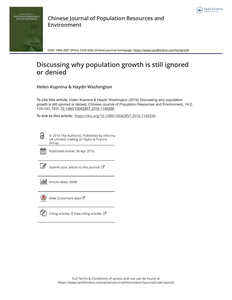For interspecies justice, animal welfare, and animal rights, the planet needs to be divided on the basis of species' natural resource requirements. The Half-Earth View is that to maintain viable populations of the Earth's remaining species, half of landscapes and seascapes need protection from intensive economic activity. This protection is needed outside the nature preserve system, such as in agricultural areas or cities, so nature can co-exist with local communities. LinkedIn: https://www.linkedin.com/in/helenkopnina/
MULTIFILE

Pedagogical Content Knowledge (PCK) is the knowledge teachers use to teach a specific subject to a specific audience. The importance of PCK to quality teaching is widely recognized. However, an overview of research about geography teachers’ PCK is missing. To fill this gap, we conducted a systematic review. We analyzed 43 empirical studies, but only 9 used PCK as a framework. Most studies addressed instructional strategies or teaching orientations. The studies were too diverse to draw conclusions on geography teachers’ PCK in general. But portraits of 16 geography teachers emphasized the necessity of geographical knowledge and teaching experience for PCK-quality.
LINK
Paper presented at ATLAS Annual Conference 2025 – Tourist destinations at a crossroads. Space, community, products, politics and evolutionary processes in the age of transitions., Vila-Seca, Spain.
DOCUMENT
How come Open Science is a well-shared vision among research communities, while the prerequisite practice of research data management (RDM) is lagging? This research sheds light on RDM adoption in the Dutch context of universities of applied sciences, by studying influencing technological, organizational, and environmental factors using the TOE-framework. A survey was sent out to researchers of universities of applied sciences in the Netherlands. The analyses thereof showed no significant relation between the influencing factors and the intention to comply with the RDM guidelines (p-value of ≤ .10 and a 90% confidence level). Results did show a significant influence of the factor Management Support towards compliance with a p-value of 0.078. This research contributes towards the knowledge on RDM adoption with the new insight that the factors used in this research do not seem to significantly influence RDM adoption in the Dutch context of universities of applied sciences. The research does show that the respondents have a positive attitude in their intention to change, increase or invest time and effort towards RDM compliance. More research is advised to uncover factors that do significantly influence RDM adoption among universities of applied sciences in the Netherland for stakeholders in Open Science and RDM to enhance their strategies.
MULTIFILE

Due to a number of factors outlined in this article, the issue of population growth is excluded from the sustainability discussion. In this article, we explore some of the ethical presumptions that underlie the issues linking population growth and sustainability. Critics argue that action to address population creates social and economic segregation, and portray overpopulation concerns as being “anti-poor,” “anti-developing country,” or even “antihuman.” Yet, de-linking demographic factors from sustainability concerns ignores significant global realities and trends, such as the ecological limits of the Earth, the welfare and long-term livelihood of the most vulnerable groups, future prospects of humanity, as well as the ecosystems that support society. https://doi.org/10.1080/10042857.2016.1149296 LinkedIn: https://www.linkedin.com/in/helenkopnina/
MULTIFILE

This publication is a report of the summer research School symbiocene, which took place at Zeeburgereiland amsterdam between the 28th and 30th of june 2023. This summer research school is anInitiative of an kramer, action researcher of the Symbiocene, in collaboration with Inholland University of applied sciences and sluislab, social Impact island.
DOCUMENT

Ecocentrism is the broadest term for worldviews that recognize intrinsic value in all lifeforms and ecosystems themselves, including their abiotic components. Anthropocentrism, in contrast, values other lifeforms and ecosystems insofar as they are valuable for human well-being, preferences and interests. Herein, the authors examine the roots of ecocentrism and discuss its mixed history of international recognition. They argue that non-human nature has intrinsic value irrespective of human preferences or valuation, and they refute the claim that ecocentrism is misanthropic. They then summarize four key examples from the academic literature in which anthropocentrism fails to provide an ethic adequate for respecting and protecting planet Earth and its inhabitants. The authors conclude that ecocentrism is essential for solving our unprecedented environmental crisis, arguing its importance from four perspectives: ethical, evolutionary, spiritual and ecological. They contend that a social transformation towards ecocentrism is not only an ethical but a practical imperative, and they urge support for ecocentric understanding and practices. https://www.ecologicalcitizen.net/article.php?t=why-ecocentrism-key-pathway-sustainability https://www.linkedin.com/in/helenkopnina/
MULTIFILE
